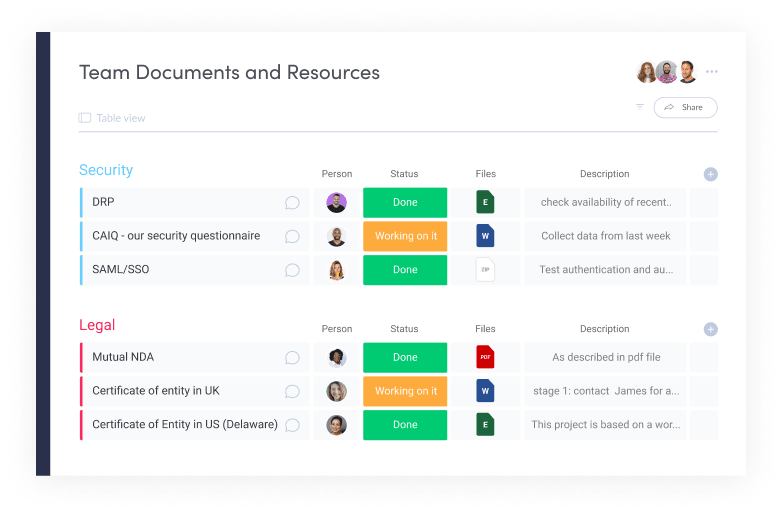A scope of work document is one of the most critical elements standing between you and a successful project. Without one, you risk misunderstandings, endless revisions, and the dreaded scope creep, where small requests gradually derail your timeline and budget.
Writing a clear scope of work takes time and research, but it’s an investment that project managers swear by. It provides the clarity and authority needed to keep projects on track, on time, and on budget.
In this guide, we’ll break down what a scope of work is, what to include, and how to write one step-by-step. We’ll also show you how to use monday.com to manage your project scope and avoid common pitfalls.
TL;DR
A scope of work is a detailed document that outlines a project’s tasks, deliverables, deadlines, and boundaries to prevent misunderstandings and ‘scope creep.’ Using a template and a platform like monday.com helps ensure clarity and keeps everyone aligned from start to finish.
What is a scope of work?
A scope of work is a formal document that provides a detailed breakdown of all the work a project involves. It sets specific limits and boundaries by defining the project’s tasks, goals, deliverables, deadlines, and expectations for everyone involved. More importantly, it also clarifies what is not part of the project.
This document is typically a key section within a larger agreement called a statement of work (SOW), which outlines the entire project agreement between a client and the agency or team executing the work.
Scope of work vs. Statement of Work (SOW): What’s the difference?
People often use the terms “scope of work” and “statement of work” (SOW) interchangeably, but they serve different functions. The scope of work is a detailed description of the project tasks, while the SOW is the overarching document that governs the entire business relationship.
Think of it this way: the SOW is the complete contract, and the scope of work is the chapter that explains exactly what will be done. Here’s a simple breakdown of the key differences:
Why is a scope of work essential for project success?
A well-defined scope of work saves you time, money, and unnecessary headaches. It aligns expectations between your team and stakeholders, ensuring everyone has the same understanding of the project’s goals and outcomes from day one.
Most importantly, it gives you the power to say “no” with confidence. When new requests or initiatives come up, you can evaluate them against the agreed-upon scope. If a request falls outside the original agreement, the scope of work serves as the foundational document for discussing changes to the timeline, budget, or resources. This is your best defense against scope creep.

What to include in a scope of work: A complete checklist
A comprehensive scope of work leaves no room for interpretation. Here are the essential components every scope document should include.
Project objectives and goals
Start with the “why” behind the project. What business goal does this project help achieve? This section should clearly state the purpose and the desired outcome, providing context for all the tasks and deliverables that follow.
Key deliverables
List every tangible output the project will produce. Be as specific as possible. For a product, include dimensions, features, and materials. For a marketing campaign, list the exact assets to be created, like blog posts, social media ads, and a landing page.
Project timeline and milestones
Outline the complete project schedule, including start and end dates, key phases, and major milestones. Milestones are significant checkpoints that mark the completion of a major set of deliverables, helping track progress against the overall timeline.
Reporting and communication plan
Define how and when you will report on project progress. This includes the frequency of status updates, the format of reports (e.g., dashboard link, weekly email), and who the key points of contact are for both the project team and the stakeholders.
Project exclusions (What’s out of scope)
This is one of the most important sections for preventing scope creep. Clearly state what is not included in the project. For example, if you are redesigning a website, you might specify that content creation or SEO optimization are out of scope.
Acceptance criteria and sign-off process
Define what “done” looks like. Acceptance criteria are the specific conditions that must be met for a deliverable to be approved. This section should also outline the formal process for stakeholders to review, approve, and sign off on deliverables.
How to write a scope of work in 6 steps
Writing a scope of work document doesn’t have to be daunting. Follow these six steps to create a clear, comprehensive, and effective plan.
Step 1: Start with a clear introduction and project purpose
Begin by reiterating the final goal of the project. The objective should answer the question, “What do we hope to achieve with this project?” This section sets the stage and ensures everyone is aligned on the high-level vision before diving into the details. You need to find a balance between being detailed enough to provide clarity and broad enough to allow for flexibility. A scope that’s too vague leaves room for interpretation, which can cause trouble later.

Using a template like monday.com’s Project Plan Template can help you clearly define the problem, set clear descriptions of goals, and visualize those goals from the start.
Step 2: Outline your deliverables and tasks
Now it’s time to break down the work. Create an exhaustive list of all the major tasks required to produce the final deliverables. Focus on key actions like “redesign the homepage” or “develop the user authentication feature.” You don’t need to list every single daily to-do, but you should capture all the big pieces of the puzzle. A work breakdown structure is a great tool for this process.
Step 3: Create a realistic project schedule with milestones
With your tasks defined, you can now estimate how long the project will take. Create a detailed timeline with start dates, end dates, and key milestones. For large projects, break the schedule into phases, with each milestone representing the completion of a significant deliverable. Visual tools like a Gantt chart can help you map out dependencies and visualize your entire schedule. Always factor in some buffer time for unexpected delays or obstacles.

Step 4: Define reporting and stakeholder communication
Establish a clear communication plan. Specify how often you’ll provide progress updates, what format they’ll take, and who needs to be kept in the loop. This ensures stakeholders are informed and engaged throughout the project lifecycle, which helps build trust and prevent surprises.
Step 5: Clearly state assumptions and exclusions
Document any assumptions you’ve made during the planning process, such as the availability of key resources or stakeholder response times. Then, create a detailed list of what is explicitly out of scope. This section is crucial for managing expectations and provides a clear reference point if new requests arise. You can also outline the budget and payment terms here. A cost breakdown structure can help with this task.
Step 6: Get formal sign-off from all stakeholders
The final step is to get agreement from all parties involved. Review the scope of work document together and ensure everyone understands and agrees to the terms, deliverables, and acceptance criteria. A formal signature turns the document into an enforceable agreement and protects you from disputes later on. Once it’s signed, you’re ready to get to work.
Free scope of work template and example
To help you get started faster, we’ve created a free, downloadable scope of work template. It includes all the essential sections covered in this guide, so you can simply fill in the blanks for your next project.
Here’s a brief example of what a deliverable might look like in a scope of work for a website redesign project:
Deliverable 1.1: Homepage Mockup
- Description: A high-fidelity, non-interactive visual design of the new website homepage.
- Acceptance Criteria: Mockup must adhere to the company’s brand style guide, include all specified content sections, and be approved by the Head of Marketing.
- Due Date: October 25, 2024
How to manage your scope of work and prevent creep with monday.com
Writing the scope of work is just the beginning. The real challenge is managing it throughout the project lifecycle. monday.com Work OS provides a flexible platform to plan, track, and manage your project scope from start to finish.
With monday.com, you can build a centralized board to track every task, deliverable, and milestone outlined in your scope. Everything is color-coded and customized to your workflow, so you’re not stuck with a rigid framework. You can use features like:
- Forms to standardize project requests and ensure you capture all necessary information upfront.
- Gantt charts and Timeline Views to visualize your schedule, track dependencies, and monitor progress against your milestones.
- Automations to create a formal scope change control process. When a change request is submitted, an automation can notify stakeholders, create an approval task, and update the project plan once approved.
- Dashboards to get a real-time, high-level view of your project’s health, helping you spot potential scope creep before it becomes a problem.
You can even use the monday.com AI Assistant to help draft initial project objectives, summarize progress reports, or generate task lists, saving you valuable planning time.

By leveraging the power of monday.com, you can ensure your team sticks to the project scope and delivers successful outcomes every time. To get started, try our Project Proposal Template.
FAQs
 Get started
Get started 


